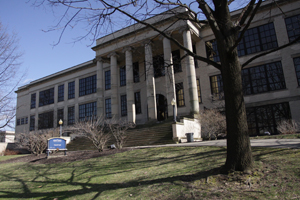Merrill Hall: The original heart of campus

Merrill Hall is the oldest building at Kent State having been built in 1913. Merrill Hall houses the sociology department for Kent State. Photo by Brian Smith.
October 20, 2019
Imagine a college campus where every department is located in the same building. It sounds odd, but at one point, Kent State used just a single building on campus to accommodate several disciplines.
Atop Hilltop Drive stands Merrill Hall. Built in 1912, it is the oldest building on campus, and one of five buildings representing Kent State’s early years as a normal school preparing teachers for higher education.
Kent, Moulton, Lowry and Cartwright halls later joined Merrill, creating what is now called Front campus. Departments entered these buildings as their departments grew.
Merrill and Lowry Hall were both built from an appropriation of $150,000. In “The Years of Youth: Kent State University 1910-1960,” author Phillip R. Shriver described plans for the buildings being “rushed to completion” in preparation for the school’s first summer term.
Merrill Hall began serving students in May 1913. The building housed 47 students and 20 faculty members. In June, attendance increased to 290 students as a second term began.
The building is dedicated to Frank A. Merrill, one of Kent State’s first Board of Trustees members in 1911. He served as the treasurer. He was also one of several trustees responsible for appointing John Edward McGilvrey as the school’s first president and naming the school in honor of William Stewart Kent.
Merrill Hall, like several other buildings located at Front campus, was built in a “Neo-Classic Revival idiom” with a facade and several columns. They were designed by the school architect, George F. Hammond, who was appointed by Kent State’s trustees to develop the young college’s first master plan.
While the building’s exterior appears classical, the same cannot be said for its interior, which experienced several changes throughout its lifespan. Larger office space and technological improvements comprised most projects.
However, construction across campus minimized Merrill’s tenants as the departments scattered across the area. In 1992, the Department of Mathematical Sciences left Merrill for the new Math and Computer Sciences building.
The Department of Sociology relocated from Lowry to Merrill. Professor Bebe Lavin, chairperson of Sociology and Anthropology, told the Daily Kent Stater in 1990 the department outgrew its space in Lowry years ago.
Merrill’s rededication happened April 5, 1995, introducing a new computer lab and overhead projectors for professional use. In 1999, the “Behind the Brain Plaza” exhibit opened, adding unique sculptures and sitting areas behind Merrill.
Little has changed to Merrill Hall since then. Enhanced accessibility in 2017 was the last major improvement to the building. Faculty and students are mixed on whether it needs renovation.
“This facility is not bad,” said Assistant professor Allen Lowery. “In my mind, the money could be spent on students. It would benefit them more than refurbishing a building that might not need refurbished.”
Jewel Yokie, senior sociology major, said the classroom experience was not bad, but could be improved.
“More modern classrooms have longer desks and here we still have individual, squeaky desks,” Yokie said. “Which make group work a little bit annoying, because either everybody has to get up and move or you have to drag your seats together to make a group.”
A lack of advanced technology was another critique, Yokie said.
“I’ve had a professor wheel in a television for us,” she said. “I was like, ‘What is happening?’”
Lowery suggested technological improvements across the university would narrow the connection between students and professors.
“The movement is toward online education,” Lowery said. “I think tying the technology together would be a big plus for future growth. It’s easier for me to bring in things from the outside into the classroom.”
Renovations to Merrill Hall are not included in the master plan. If improvements are made, it should be to enhance the student’s learning ability, said Lowery.
“If the students aren’t comfortable, they’re not going to learn as well. On the other hand, you don’t want them to be too comfortable, [or] they’ll go to sleep.”
Contact Nick Lavrisiuk at [email protected].
























